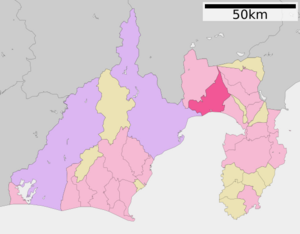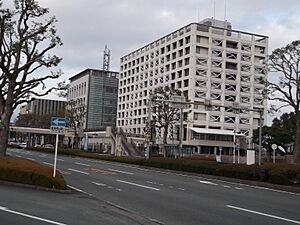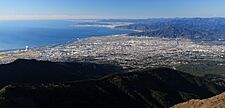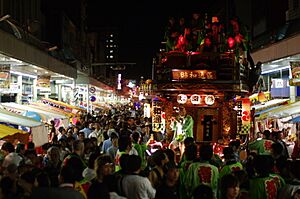Fuji, Shizuoka facts for kids
Quick facts for kids
Fuji
富士市
|
|||||||||||
|---|---|---|---|---|---|---|---|---|---|---|---|

Factories and Mount Fuji
|
|||||||||||
|
|||||||||||
 |
|||||||||||
| Country | Japan | ||||||||||
| Region | Chūbu (Tōkai) | ||||||||||
| Prefecture | Shizuoka | ||||||||||
| Area | |||||||||||
| • Total | 244.95 km2 (94.58 sq mi) | ||||||||||
| Population
(December 1, 2019)
|
|||||||||||
| • Total | 245,015 | ||||||||||
| • Density | 1,000.265/km2 (2,590.68/sq mi) | ||||||||||
| Time zone | UTC+9 (Japan Standard Time) | ||||||||||
| Phone number | 0545-51-0123 | ||||||||||
| Address | 1-100 Nagatachō, Fuji-shi, Shizuoka-ken 417-8601 | ||||||||||
| Climate | Cfa | ||||||||||
|
|||||||||||
Fuji (富士市, Fuji-shi) is a city in eastern Shizuoka Prefecture, Japan. It is a special city, meaning it has more control over its own local government. As of December 2019, about 245,000 people live in Fuji. The city covers an area of about 245 square kilometers. Fuji is the third largest city in Shizuoka Prefecture by population.
Contents
Geography of Fuji
Fuji city is located along the Fuji River. Many parts of the city offer amazing views of Mount Fuji. Part of the famous mountain's summit is actually inside the city's borders. To the south, Fuji city is next to Suruga Bay on the Pacific Ocean.
Neighboring Towns and Cities
Fuji is surrounded by several other towns and cities in Shizuoka Prefecture:
- Fujinomiya
- Gotemba
- Nagaizumi
- Numazu
- Shimizu-ku, Shizuoka
- Susono
Population Growth in Fuji
The number of people living in Fuji has grown a lot over the last 50 years. This shows that more and more people are choosing to live in this city.
| Historical population | ||
|---|---|---|
| Year | Pop. | ±% |
| 1960 | 155,780 | — |
| 1970 | 195,598 | +25.6% |
| 1980 | 222,480 | +13.7% |
| 1990 | 239,963 | +7.9% |
| 2000 | 251,559 | +4.8% |
| 2010 | 254,049 | +1.0% |
Fuji's Climate
Fuji has a climate with hot and humid summers. Its winters are usually quite mild. The average temperature in Fuji throughout the year is about 16.2 degrees Celsius. The city gets a lot of rain, especially in September.
History of Fuji City
The area that is now Fuji has a long history. During the Edo period (1603-1868), an important road called the Tōkaidō passed through here. There was a special stop for travelers called Yoshiwara-juku.
Over time, several smaller towns and villages in the area grew and merged. In 1929, the village of Kajima became the town of Fuji. Later, in 1954, the towns of Tagoura and Iwamatsu joined with Fuji.
A big change happened on November 1, 1966. The city of Fuji, along with Yoshiwara and Takaoka, merged to form the new, larger city of Fuji. This new city became a Special City in 2001. This gave it more independence from the central government. In 2008, the town of Fujikawa also joined Fuji.
Economy and Industries
Fuji is a very important industrial area in Shizuoka Prefecture. It is well-known for its many paper factories. Companies like Nippon Paper Industries have been here for a long time. Other major industries include making food products, metal goods, and transportation equipment.
A big company that makes car parts, called Jatco, has its main office in Fuji. Besides industries, farming is also important. Farmers in Fuji grow a lot of green tea and other plants.
Education in Fuji
Fuji city has many schools for young people. The city government runs 27 public elementary schools and 16 public junior high schools. There are also five public high schools, with one run by the city and four by the prefecture. Fuji also has one private high school and one private school that combines middle and high school.
For students with special needs, there is a special education school. Fuji is also home to a campus of Tokoha University. The city has several vocational schools that teach job skills. There is even an international school called Escola Fuji, which is a Brazilian primary school.
Transportation in Fuji
Fuji is a hub for transportation, making it easy to travel around Japan.
Train Lines
 Central Japan Railway Company - The fast Tōkaidō Shinkansen bullet train stops at Shin-Fuji Station.
Central Japan Railway Company - The fast Tōkaidō Shinkansen bullet train stops at Shin-Fuji Station. Central Japan Railway Company - The local Tōkaidō Main Line connects Fuji to other cities.
Central Japan Railway Company - The local Tōkaidō Main Line connects Fuji to other cities. Central Japan Railway Company - The Minobu Line also runs through Fuji.
Central Japan Railway Company - The Minobu Line also runs through Fuji. Gakunan Railway Line - This local line has several stations within Fuji.
Gakunan Railway Line - This local line has several stations within Fuji.
Major Roads
 Tōmei Expressway
Tōmei Expressway Shin-Tōmei Expressway
Shin-Tōmei Expressway- Nishi-Fuji Road
- National Routes: Route 1, Route 139, Route 469
Port
- Tagonoura Port is an important port for trade and shipping.
Fun Things to See and Do
Fuji has some interesting places to visit and exciting festivals.
- Sengen Kofun is an ancient burial mound and a National Historic Site.
Festivals in Fuji
- Bishamonten Festival: This is one of Japan's three biggest Daruma (a traditional doll) festivals.
- Yoshiwara Gion Festival: Held every year on the second Saturday and Sunday of June.
- Fuji Festival: Takes place on the fourth Saturday of July.
- Karigane Festival: Celebrated on the first Saturday of October.
- Fuji Shibazakura Festival: A beautiful festival featuring pink moss flowers.
Famous People from Fuji
Many talented people come from Fuji, including:
- Urara Ashikawa - A professional artistic gymnast.
- Yoshikatsu Kawaguchi - A professional soccer player.
- Takuro Kikuoka - A professional soccer player.
- Daigo Kobayashi - A professional soccer player.
- Shuji Kondo - A professional wrestler.
- Makoto Oishi - A professional wrestler.
- Yukihiko Sato - A professional soccer player.
- Hiroyuki Shirai - A professional soccer player.
- Mitsuru Sugaya - A manga artist (comic book artist).
- Miyu Takahira - A professional soccer player.
- Tatsuya Tsuruta - A professional soccer player.
- Yoji Totsuka - A scientist.
Sister Cities
Fuji has a special friendship with another city:
 Oceanside, California, United States
Oceanside, California, United States
See also
 In Spanish: Fuji (Shizuoka) para niños
In Spanish: Fuji (Shizuoka) para niños









